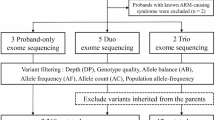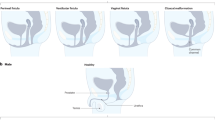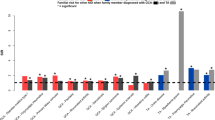Abstract
Familial recurrence of anorectal malformations (ARMs) has been reported in single institution case series and in two population-based studies. Here, we investigate the familial aggregation of ARMs using well-established, unbiased methods in a population genealogy of Utah. Study subjects included 255 ARM cases identified from among the two largest healthcare providers in Utah with linked genealogy data using International Classification of Diseases, Ninth Revision (ICD-9) diagnosis codes. The genealogical index of familiality (GIF) statistic, which compares the average pair-wise relatedness of cases to sets of matched controls, was used to test excess familial clustering. We also estimated relative risks (RRs) for ARM and associated phenotypes in relatives of cases adjusting for age-, sex-, and birthplace. Significant excess familial clustering was observed for all ARM subjects (GIF p < 1e-3). Significant RR estimates for ARM (RR = 15.6, p = 3.3e-6), and for almost all co-morbid birth defects previously associated with ARM, were observed among first-degree relatives of ARM case subjects. This genealogically-based population survey of familial aggregation of ARMs confirms the presence of a heritable component to ARMs and provides unbiased risk estimates to relatives of cases, which may have clinical utility.
Similar content being viewed by others
Log in or create a free account to read this content
Gain free access to this article, as well as selected content from this journal and more on nature.com
or
References
Mundt E, Bates MD. Genetics of Hirschsprung’s disease and anorectal malformations. Semin Pediatr Surg. 2010;19:107–17.
Wijers CHW, van Rooij I, Macelis C, Brunner H, de Blaauw I, Roeleveld N. Genetic and non-genetic etiology of nonsyndromic anorectal malformations: a systematic review. Birth Defects Res C Embryo Today. 2014;102:382–400.
Quan L, Smith DW. The VATER association. Vertebral defects, anal atresia, T-E fistula, with esophageal atresia, radial and renal dysplasia: a spectrum of association defects. J Pediatr. 1973;82:104–7.
Solomon BD. VACTERL/VATER Association. Orphanet J Rare Dis. 2011;6:56.
Oyen N, Boyd HA, Poulsen G, Wohlfahrt J, Melbye M. Familial recurrence of midline birth defects – a nationwide Danish cohort study. Am J Epidemiol. 2009;170:46–52.
Falcone RA, Levitt MA, Pena A, Bates M. Increased heritability of certain types of anorectal malformations. J Ped Surg. 2007;42:124–8.
Solomon BD, Pineda-Alvarez DE, Raam MS, Cummings DAT. Evidence for inheritance in patients with VACTERL association. Hum Genet. 2010;127:731–3.
Skolnick MH. The Utah genealogical database: a resource for genetic epidemiology. In: Cairns J, Lyon JL, Skolnick M, editors. Banbury report No. 4: cancer incidence in defined populations. New York, NY: Cold Spring Harbor Laboratories; 1980. p. 285–97.
Albright F, Teerlink C, Werner TL, Cannon-Albright LA. Significant evidence for a heritable contribution to cancer predisposition: A review of cancer familiality by site. BMC Cancer. 2012;12:138.
Kauwe JSK, Ridge PG, Foster NL, Cannon-Albright LA. Strong evidence for a genetic contribution to late-onset Alzheimer’s Disease mortality: a population-based study. PLoS ONE. 2013;8:e77087.
Yates WR, Johnson C, McKee P, Cannon-Albright LA. Genetic analysis of low BMI phenotype in the Utah population database. PLoS ONE. 2013;8:e80287.
Teerlink CC, Albright FS, Lins L, Cannon-Albright LA. A comprehensive survey of cancer risks in extended families. Genet Med. 2012;14:107–14.
Albright F, Stephenson RA, Agarwal N, Teerlink CC, Lowrance WT, Farnham JM, et al. Prostate cancer risk prediction based on complete prostate cancer family history. Prostate. 2015;75:390–8.
Marcelis C, de Blaauw I, Brunner H. Chromosomal anomalies in the etiology of anorectal malformations: A review. Am J Med Genet Part A. 2011;155:2692–704.
de Blaauw I,Wijers CHW, Schmiedeke E, Holland-Cunz S, Gambaf P, Marcelis CLM, Reutter H, Aminoff D, Schipper M, Schwarzer N, Grasshoff-Derrm S, Midrio P, Jenetzky E, van Rooij IALM. First results of a European multi-center registry of patients with anorectal malformations. J Ped Surg. 2013;48:2530–5.
Hofmann AD, Puri P. Association of Hirschsprung’s disease and anorectal malformation: a systematic review. Pediatr Surg Int. 2013;29:913–7.
Acknowledgements
Partial support for all data sets within the Utah Population Database (UPDB) was provided by Huntsman Cancer Institute, Huntsman Cancer Foundation, University of Utah, and the Huntsman Cancer Institute’s Cancer Center Support grant, P30 CA42014 from National Cancer Institute. Financial support for data analysis was provided by Primary Children’s Foundation, Salt Lake City, UT, USA.
Author information
Authors and Affiliations
Corresponding author
Ethics declarations
Conflict of interest
The authors declare that they have no conflict of interest.
Rights and permissions
About this article
Cite this article
Teerlink, C.C., Bernhisel, R., Cannon-Albright, L.A. et al. A genealogical assessment of familial clustering of anorectal malformations. J Hum Genet 63, 1029–1034 (2018). https://doi.org/10.1038/s10038-018-0487-y
Received:
Revised:
Accepted:
Published:
Issue date:
DOI: https://doi.org/10.1038/s10038-018-0487-y
This article is cited by
-
Swenson-like pull-through for treatment of the rare association between Hirschsprung’s disease and anorectal malformation
BMC Pediatrics (2025)
-
Concurrent Hirschsprung’s disease and anorectal malformation: a systematic review
Pediatric Surgery International (2020)



